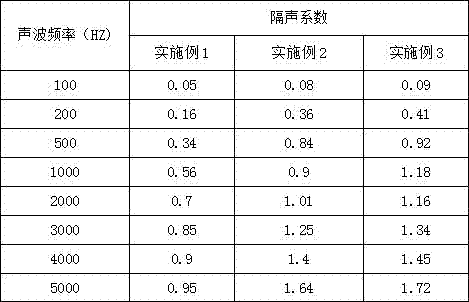Energy-saving glass for doors and windows
A technology for energy-saving glass, doors and windows, applied in polyester coatings, polyurea/polyurethane coatings, coatings, etc., can solve the problems of energy-saving and heat insulation performance not meeting the requirements, inability to apply energy-saving renovation of architectural glass, secondary light pollution, etc., to achieve Beautiful appearance, good sound-absorbing effect, and high internal opening rate
- Summary
- Abstract
- Description
- Claims
- Application Information
AI Technical Summary
Problems solved by technology
Method used
Image
Examples
Embodiment 1
[0020] An energy-saving glass for doors and windows, comprising a glass substrate and an energy-saving coating coated on the surface of the glass substrate, characterized in that the glass substrate includes the following raw materials: 80 grams of waste glass, 3 grams of ground calcium carbonate, 1 gram of coarse borax gram, 1 gram of zinc white, 1 gram of boron oxide, 10 grams of sodium oxide, 1 gram of iron oxide, 10 grams of magnesium oxide, 10 grams of aluminum oxide, 10 grams of calcium oxide, 30 grams of silicon oxide, 1 gram of magnesium oxide and 50 grams of water ;
[0021] The energy-saving coating includes the following raw materials: 30 grams of resin, 25 grams of powder filler, 10 grams of hollow ball filler, 10 grams of alkyd polymer, 10 grams of polyvinylpyrrolidone and 30 grams of water.
[0022] The resin is a mixture of modified water-based polyurethane resin, modified water-based acrylic resin, polymethyl methacrylate, propylene-styrene resin and propylene-...
Embodiment 2
[0030] An energy-saving glass for doors and windows, comprising a glass base material and an energy-saving coating coated on the surface of the glass base material, characterized in that the glass base material includes the following raw materials: 90 grams of waste glass, 9 grams of ground calcium carbonate, coarse borax 2 gram, 2 grams of zinc white, 2 grams of boron oxide, 15 grams of sodium oxide, 5 grams of iron oxide, 20 grams of magnesium oxide, 20 grams of aluminum oxide, 15 grams of calcium oxide, 50 grams of silicon oxide, 2 grams of magnesium oxide and 70 grams of water ;
[0031] The energy-saving coating includes the following raw materials: 70 grams of resin, 80 grams of powder filler, 55 grams of hollow ball filler, 20 grams of alkyd polymer, 20 grams of polyvinyl pyrrolidone, 60 grams of water and 5 grams of additives.
[0032] The resin is a mixture of modified water-based polyurethane resin, modified water-based acrylic resin, polymethyl methacrylate, propyle...
Embodiment 3
[0040] An energy-saving glass for doors and windows, comprising a glass substrate and an energy-saving coating coated on the surface of the glass substrate, characterized in that the glass substrate includes the following raw materials: 85 grams of waste glass, 6 grams of ground calcium carbonate, 1.5 grams of coarse borax 1.5 grams of zinc white, 1.5 grams of boron oxide, 13 grams of sodium oxide, 3 grams of iron oxide, 15 grams of magnesium oxide, 15 grams of aluminum oxide, 13 grams of calcium oxide, 40 grams of silicon oxide, 1.5 grams of magnesium oxide and 60 grams of water ;
[0041]The energy-saving coating includes the following raw materials: 50 grams of resin, 55 grams of powder filler, 35 grams of hollow ball filler, 15 grams of alkyd polymer, 15 grams of polyvinylpyrrolidone, 45 grams of water and 3 grams of additives.
[0042] The resin is a mixture of modified water-based polyurethane resin, modified water-based acrylic resin, polymethyl methacrylate, propylene-...
PUM
| Property | Measurement | Unit |
|---|---|---|
| Particle size | aaaaa | aaaaa |
| Particle size | aaaaa | aaaaa |
| Particle size | aaaaa | aaaaa |
Abstract
Description
Claims
Application Information
 Login to View More
Login to View More - R&D
- Intellectual Property
- Life Sciences
- Materials
- Tech Scout
- Unparalleled Data Quality
- Higher Quality Content
- 60% Fewer Hallucinations
Browse by: Latest US Patents, China's latest patents, Technical Efficacy Thesaurus, Application Domain, Technology Topic, Popular Technical Reports.
© 2025 PatSnap. All rights reserved.Legal|Privacy policy|Modern Slavery Act Transparency Statement|Sitemap|About US| Contact US: help@patsnap.com

